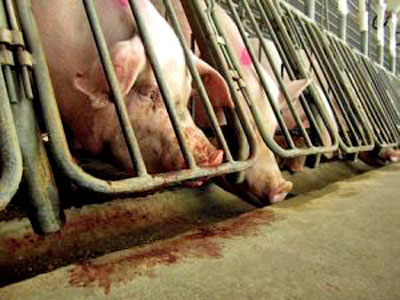|
from MotherJones Website
USDA = United States Department of Agriculture
According to peer-reviewed research, factory farms may be
a "significant
reservoir of resistant bacteria." Yum! Humane Society Here is a document (A Focus on Antimicrobial Resistance) the USDA doesn't want you to see.
It's what the agency calls a "technical review" - nothing more than a USDA-contracted researcher's simple, blunt summary of recent academic findings on the growing problem of antibiotic-resistant infections and their link with factory animal farms.
The topic is a serious one.
A single antibiotic-resistant pathogen, MRSA - just one of many now circulating among Americans - now claims more lives each year than AIDS. Back in June, the USDA put the review up on its National Agricultural Library website.
Soon after, a Dow Jones story quoted a USDA official who declared it to be based on,
She added that the report should not be seen as a,
That's fair enough - the review was
designed to sum up the state of science on antibiotic resistance and
factory farms, not the USDA's position on the matter.
And last Friday, the document (original link) vanished without comment from the agency's website.
The only way to see the document now is
through
the above-linked cached version
supplied to me by the Union of Concerned Scientists.
One of the industry's tried-and-true
tactics is low-level, daily doses of antibiotics. The practice helps
keep infections down, at least in the short term, and, for reasons
no one really understands, it pushes animals to fatten to slaughter
weight faster.
To put that number in perspective, consider that we humans in the United States - in all of our prescription fill-ups and hospital stays combined - use just over 7 million pounds per year.
Thus the vast bulk of antibiotics
consumed in this country, some 80 percent, goes to factory animal
farms.
The industry claims that even though
antibiotic-resistant bacteria have been found both in confined
animals and supermarket meat, there's simply no evidence that
livestock strains are jumping to the human population.
Assembled by Vaishali Dharmarha, a research assistant at the University of Maryland, the report summarizes research from 63 academic papers and government studies.
Here are few of her findings:
Naturally, such assertions didn't please the meat industry - and the fact that they were backed up by dozens of peer-reviewed science papers no doubt only sharpened the sting.
In the trade paper National Hog Farmer, a National Pork Producers Council official lashed out.
Perhaps lacking factual ammunition, the official resorted to an attack on the researchers' credentials:
Well, the pork producers can rest a bit easier.
The researcher, Dharmarha, has been silenced. Not only has her report been erased from the USDA site, but she has been forbidden to talk to media. I reached her by phone Thursday. She told me that she didn't know why the report had been taken down, and that she could make no further comment. She referred me to her superior, Tara Smith of the USDA's National Agriculture Library.
Smith has yet to return calls or emails.
And instead of informing the public about it, the USDA seems intent to keep it on the down-low.
Justin Tatham of the Union of Concerned Scientists, who has been observing the drama since it started in June, put it to me like this:
For me, what's even more disturbing is that government regulators know that serious trouble is brewing from antibiotic abuse on factory farms and seem incapable of acting to stop it.
Dharmarha's heresies are not the first time a government-associated person has bluntly held forth on the topic.
In 2009, Josh Sharfstein, then
deputy commissioner of
the FDA, delivered
damning testimony before the US
House of Representatives. He opined that routine use of antibiotics
on farm animals should be severely restricted - banned outright for
non-medical uses like growth promotion and used only "under the
supervision of a veterinarian" to treat sicknesses.
The FDA maintains its official stance that antibiotics should be used "judiciously" on factory farms, and it leaves it to the industry to define what that means.
|

